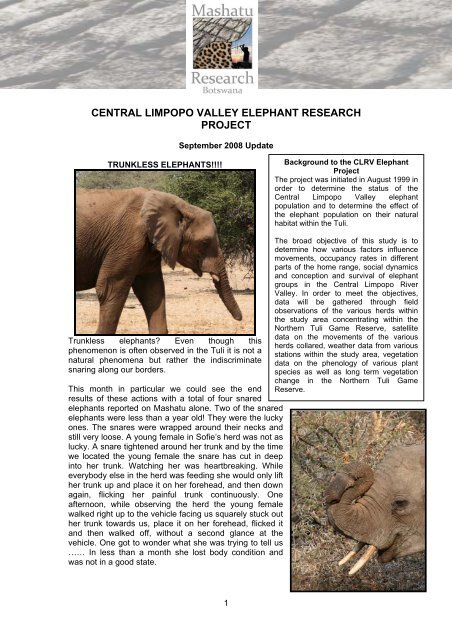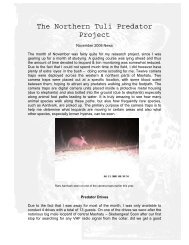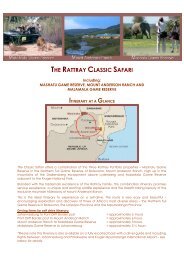central limpopo valley elephant research project - Mashatu Game ...
central limpopo valley elephant research project - Mashatu Game ...
central limpopo valley elephant research project - Mashatu Game ...
You also want an ePaper? Increase the reach of your titles
YUMPU automatically turns print PDFs into web optimized ePapers that Google loves.
CENTRAL LIMPOPO VALLEY ELEPHANT RESEARCH<br />
PROJECT<br />
September 2008 Update<br />
TRUNKLESS ELEPHANTS!!!!<br />
Background to the CLRV Elephant<br />
Project<br />
The <strong>project</strong> was initiated in August 1999 in<br />
order to determine the status of the<br />
Central Limpopo Valley <strong>elephant</strong><br />
population and to determine the effect of<br />
the <strong>elephant</strong> population on their natural<br />
habitat within the Tuli.<br />
Trunkless <strong>elephant</strong>s Even though this<br />
phenomenon is often observed in the Tuli it is not a<br />
natural phenomena but rather the indiscriminate<br />
snaring along our borders.<br />
This month in particular we could see the end<br />
results of these actions with a total of four snared<br />
<strong>elephant</strong>s reported on <strong>Mashatu</strong> alone. Two of the snared<br />
<strong>elephant</strong>s were less than a year old! They were the lucky<br />
ones. The snares were wrapped around their necks and<br />
still very loose. A young female in Sofie’s herd was not as<br />
lucky. A snare tightened around her trunk and by the time<br />
we located the young female the snare has cut in deep<br />
into her trunk. Watching her was heartbreaking. While<br />
everybody else in the herd was feeding she would only lift<br />
her trunk up and place it on her forehead, and then down<br />
again, flicking her painful trunk continuously. One<br />
afternoon, while observing the herd the young female<br />
walked right up to the vehicle facing us squarely stuck out<br />
her trunk towards us, place it on her forehead, flicked it<br />
and then walked off, without a second glance at the<br />
vehicle. One got to wonder what she was trying to tell us<br />
…… In less than a month she lost body condition and<br />
was not in a good state.<br />
The broad objective of this study is to<br />
determine how various factors influence<br />
movements, occupancy rates in different<br />
parts of the home range, social dynamics<br />
and conception and survival of <strong>elephant</strong><br />
groups in the Central Limpopo River<br />
Valley. In order to meet the objectives,<br />
data will be gathered through field<br />
observations of the various herds within<br />
the study area concentrating within the<br />
Northern Tuli <strong>Game</strong> Reserve, satellite<br />
data on the movements of the various<br />
herds collared, weather data from various<br />
stations within the study area, vegetation<br />
data on the phenology of various plant<br />
species as well as long term vegetation<br />
change in the Northern Tuli <strong>Game</strong><br />
Reserve.<br />
1
Elephants are often the victims of snares and in the nine years I have been studying<br />
these amazing creatures we had to shoot several youngsters with snares around<br />
their feet too far gone to save them. Smaller <strong>elephant</strong>s due to their inquisitive nature<br />
sometimes get their trunks caught in these wire snares. The snare will slowly tighten<br />
around the trunk and as it does it cuts deeper and deeper into the trunk eventually<br />
amputating a section of the trunk. The lucky ones are those that only loose a small<br />
portion of the trunk. They will most likely survive. The unlikely ones are those, which<br />
a large portion of the trunk is amputated. As these animals grow up they need to fend<br />
for themselves. It is nearly impossible for the animal to feed itself and even harder to<br />
obtain enough water and over time the animal will die of starvation. On the reserve,<br />
there have been amazing stories of herds taking care of these individuals feeding<br />
them over times of food shortages but eventually the outcome is the same –<br />
starvation!<br />
The Wildlife Department was called as soon as the snared <strong>elephant</strong>s were reported<br />
and confirmed and a veterinarian will be coming out to the reserve early in October to<br />
assist with the snares. Unlike the predators this is not a task we can do ourselves.<br />
The drug used in darting an <strong>elephant</strong> is highly scheduled and only a registered<br />
veterinarian is allowed to dart. It is also a dangerous operation especially when less<br />
than a year old babies are involved. We will monitor the various herds as best we can<br />
(only one herd is collared) until the arrival of the Wildlife veterinarian and hopefully<br />
we can rescue these youngsters from a very painful and most likely fatal experience.<br />
Ivory Drives<br />
During this month a total<br />
of 57 guests participated<br />
in the Ivory Experience<br />
and 8 volunteers partook<br />
in the Research Shadow<br />
Program. A total of 18<br />
different herds were<br />
observed during the<br />
month but the family that<br />
was most often seen was<br />
that of Hestelle with<br />
Charge’s group a close<br />
second. Herds during the<br />
month were mostly seen<br />
either walking or<br />
browsing on the thorny<br />
Acacia trees along the Majale and Limpopo rivers.<br />
On most of the drives we ended up sitting amongst the <strong>elephant</strong>s as they hungrily fed<br />
on the Acacia trees wondering how on earth they manage to eat those thorny twigs.<br />
The babies are growing up fast and as they do they get more adventurous. Bored<br />
with everyone else chomping away on the trees the babies often use the game<br />
viewer as a big toy. An interesting behaviour this month was seen on an afternoon<br />
visit to Cheeky’s herd. We met up with the herd on a very hot afternoon, far from any<br />
2
water source. Two females on two separate occasions urinated and then stepped<br />
back and sprayed themselves with their urine as a means to cool down.<br />
Email list<br />
Should you have received this update “via the grapevine” and would like me to email<br />
it to you directly in future, please send me an email<br />
(mashatu.<strong>research</strong>@telkomsa.net) and I will add you to the mailing list. Please note<br />
that I do not have regular email contact and may not respond to email for several<br />
weeks at time, and this also hampers getting regular updates out.<br />
Best wishes<br />
Jeanetta Selier<br />
Project Sponsors<br />
3




